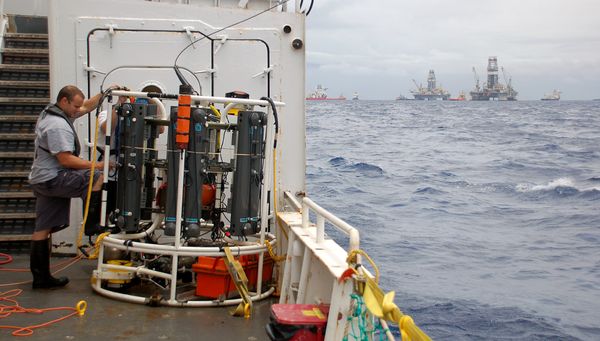
Giant Underwater Plume ConfirmedâGulf Oil Not Degrading
Christine Dell'Amore National Geographic News
A giant plume from BP's Gulf of Mexico oil spill has been confirmed deep in the ocean—and there are signs that it may stick around, a new study says.
Many scientists had predicted that oil-eating bacteria—already common in the Gulf due to natural oil seeps—would process much of the crude leaked from BP's Deepwater Horizon wellhead, which was capped July 15. (Read more about how nature is fighting the oil spill.)

WHOI's Richard Camilli and Chris Reddy (behind apparatus) aboard a research vessel in the Gulf of Mexico
But new evidence shows that a 22-mile-long (35-kilometer-long), 650-foot-high (200-meter-high) pocket of oil has persisted for months at depths of 3,600 feet (1,100 meters), according to a team from Woods Hole Oceanographic Institution (WHOI) in Massachusetts.
(Related: "Much Gulf Oil Remains, Deeply Hidden and Under Beaches.")
The oil plume's stability is "a little unexpected," study leader Richard Camilli, of WHOI's Applied Ocean Physics and Engineering Department, said at a Thursday press briefing in Washington, D.C.
"We don't have any clear indication as to why it set up at that depth."
It's unclear why the Gulf's microbes aren't eating the oil plume, but the organisms are infamous for being unpredictable, said study co-author Christopher Reddy, a marine chemist at WHOI.
Counting on microbes to quickly clean up an oil spill is "like asking a teenager to do a chore. You tell them to do it on a Friday, to do it when it's most advantageous, and they do it on a Saturday," Reddy told National Geographic News earlier this month.
Further studies are needed to figure out why the plume isn't degrading, Reddy said during the press briefing: "We don't live in the world of the TV show CSI. ... Patience is a virtue."
Hard Evidence for Gulf Oil Plume
During a ten-day research cruise in June, the WHOI team used autonomous underwater vehicles (AUVs), free-swimming probes that are the "next generation" of remotely operated vehicles, Camilli said during the briefing.
The team's AUVs were equipped with mass spectrometers—devices that measure the masses of molecules. The spectrometers collected thousands of samples in various regions near the spill site.
Most of these samples detected hydrocarbons—ingredients of oil—at concentrations of 50 micrograms a liter.
Using this data, the scientists were able to piece together the shapes and sizes of two oil plumes: the large, deep plume and a more diffuse plume spread out between depths of 160 and 1,600 feet (50 and 500 meters).
University of South Florida (USF) chemical oceanographer David Hollander said the discovery of stubborn oil in the deep sea "falls right into line" with his recent findings.
"These hydrocarbons are plentiful, and will be around for a long time," Hollander said by email.
Hollander and a USF team announced this week that oil may have been found deep on the Gulf seafloor, and that it appears to be toxic to phytoplankton, small plants that live in the deep ocean and make up the base of the marine food chain.
It's too early to say whether the plume is harmful to marine life in the area studied by WHOI, expedition member Reddy said.
But the research does show that the oil plume hasn't yet spurred oxygen depletion in the Gulf, which can create a dead zone—a swath of ocean largely devoid of life-forms—according to Ruoying He, a physical oceanographer at North Carolina State University in Raleigh, who was not involved in the new research.
(Related: "Gulf Oil Spill a 'Dead Zone in the Making'?")
He added that the new study—published today in the journal Science—is "extremely important," in part because it offers hard evidence of the suspected oil plume in the Gulf.
"I'm happy to see some in situ observations published so quickly," he said.
How Far Will Gulf Oil Plume Go?
The study raises another fundamental question that North Carolina's He is currently modeling: How far will the Gulf oil spill travel?
The plume has already fanned out a considerable distance from the BP wellhead, He noted. At the time of the survey, the plume was migrating about 4 miles (6.5 kilometers) a day southwest from the spill site, according to the study.
And with oil-eating bacteria taking their time, it's possible that the oil could be transported even farther from the well before the crude gets degraded, WHOI's Camilli said.
(See "Gulf Oil Spill Could Reach East Coast Beaches.")
It's also possible the oil plume is already gone: "We don't know what the fate of this plume now is—this was a forensic snapshot in late June, and we have not been back there since," Camilli cautioned.
Deep-Ocean Focus Needed for Oil Cleanups
Since the toxic effects of oil and chemical dispersants are not fully known, "there is great room for debate and contrasting interpretation as to what the impacts will be," Robert Carney, a biological oceanographer at Louisiana State University (LSU) in Baton Rouge, said by email.
(Learn more about how dispersants may be harming wildlife.)
At this point, though, a "far more valuable undertaking" would be to start figuring out how to prevent doing further harm to the deep ocean, he said.
"Through this all we have witnessed an aged and untested bit of dogma dominate response decisions: Protect the beach," Carney said. (See: "Oil Found in Gulf Beach Sand, Even After Cleanups.")
"Quite obviously, it is the whole ocean that we must protect and effectively manage," he said. "We are badly in need of new ideas.
